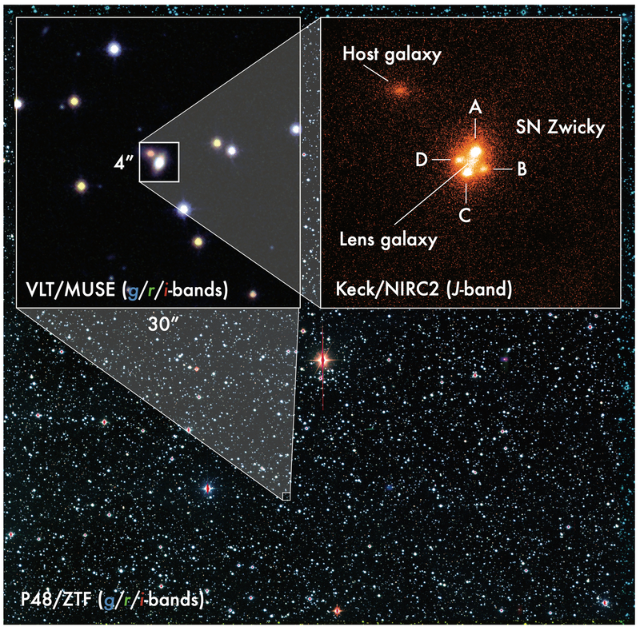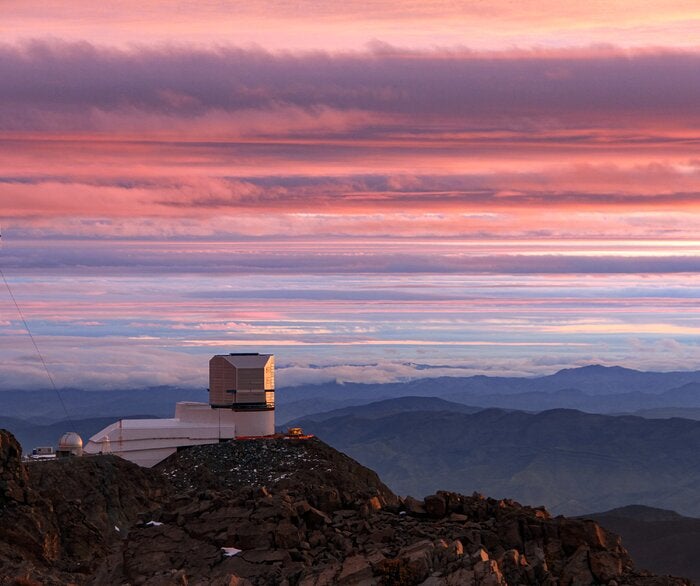
Albert Einstein first recognized that a massive, dense object in the sky can act like a lens that can bend and focus light from behind it, known as gravitational lensing. Strong gravitational lenses can magnify and even create several copies of the background image. Recently, a team of scientists discovered a rare, quadruply-lensed supernova, copied four times. Studying its light could give us a deeper insight on dark matter, the expansion of the universe, and even help measure cosmic distances.
The supernova was first detected by the Zwicky Transient Facility (ZTF), so astronomers named it SN Zwicky. Using images from the W.M. Keck Observatory, the Very Large Telescope, and NASA’s Hubble Space Telescope, the team was able to confirm the finding. “Such lensed objects can help us to uniquely probe the amount and distribution of matter at the inner core of galaxies,” said team leader and director of the Oskar Klein Centre at Stockholm University, Ariel Goobar, in a press release.
A special type of supernova
SN Zwicky is categorized as a type Ia supernova. One of the characteristics of these explosions is that they are always caused by the same type of object: a white dwarf stealing matter from a companion. Because white dwarfs have an upper mass limit, they always explode when they reach a specific mass, meaning those explosions always produce similar luminosities (or brightness). Astronomers see approximately 1,000 type Ia supernovae occur every year (in many galaxies, not just the Milky Way); the frequency of these events combined with their uniform luminosity make them a perfect type of so-called standard candle. Astronomers use sources with known luminosities as standard candles to deduce their distance based on their appearance. Such observations first showed and continue to support the idea of an accelerating, expanding universe.
The ZTF Bright Transient Survey is the largest, most complete survey for transients (which are astronomical phenomena that change brightness within a relatively short time frame). Astronomers use it to rapidly capture and classify thousands of supernovae in near-real time. This allowed Goobar’s team to quickly notice that SN Zwicky was much brighter than expected, given its distance. It wasn’t long before they realized that SN Zwicky was undergoing strong gravitational lensing that caused the image to multiply four times in a pattern surrounding the foreground (lensing) galaxy.
A unique discovery
The quadruply-lensed SN Zwicky is located 4 billion light-years away, nearly four times as far as most supernovae ZTF sees. But because SN Zwicky was magnified 25 times by a dense foreground galaxy, the telescope was able to capture its light!
The intense magnification combined with its distance offer the opportunity to look farther back in time than would otherwise be possible, giving a much clearer picture of the universe as it has evolved. “Observing more [strongly lensed type Ia supernovae] will give us an unprecedented chance to explore the nature of dark energy,” said study co-author Joel Johansson, also at Stockholm University.
This profound discovery can now shed light on properties of distant galaxies and even help reveal long-awaited answers on dark matter and dark energy. Scientists have been puzzling over dark matter and dark energy for centuries. These two components are unseen but influence the cosmos greatly: The first makes up the majority of the mass of galaxies and the second dominates the total energy density found in space. By improving our understanding of both the distant universe and the phenomenon of gravitational lensing, SN Zwicky has strong potential to aid in understanding the fundamental forces that make up our universe.









